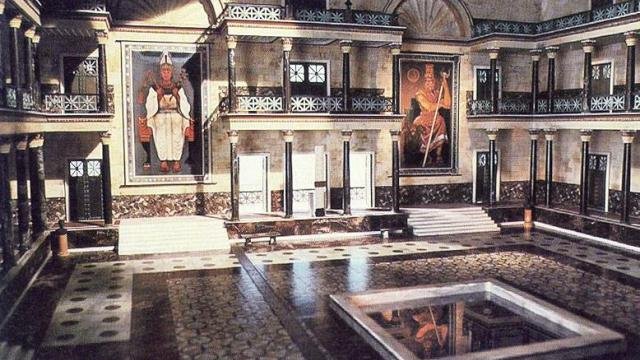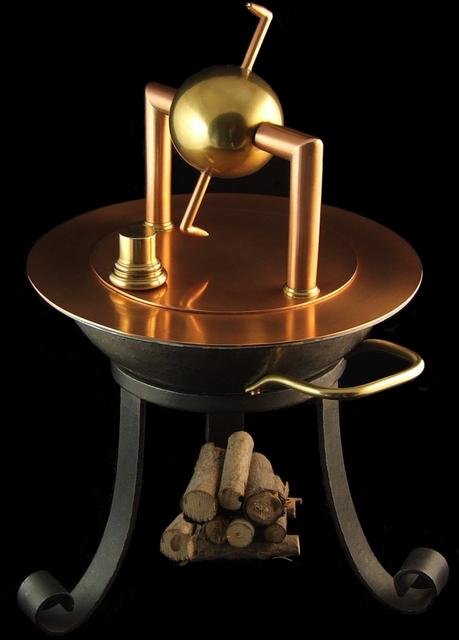Incredible Ancient Machines Invented By Hero Of Alexandria – An Engineer Far Ahead Of His Time
Ellen Lloyd – MessageToEagle.com – Little is known about Hero of Alexandria except that he was a remarkable ancient engineer far ahead of his time.
He invented several sophisticated machines that demonstrate his vast knowledge of mechanics.
Hero also called Heron, was a Greek mathematician. The date of his birth remains uncertain. Some authorities place his birthday early 150 BCE in Ptolemaic, Egypt. Other scholars date his birth to be 250 CE in late Roman Empire.
As a student, Hero spent most of his time in the Library at the University of Alexandria. He loved to be in the library, because of the series of gardens vast collection of books.
Hero was strongly influenced by the writings of Ctesibius of Alexandria. It is possible he was a student of Ctesibius.
When older he taught at the University of Alexandria, and taught mathematics, mechanics, and physical science.
He wrote many books and he used them as texts for his students, and manuals for technicians, and were written in Greek, Latin and Egyptian.
One of his amazing inventions is the so-called “The ‘philosopher’s stone’ of Heron” that “changed” one liquid into another, for example, water into wine.
It consisted of an airtight vase of water which, at the top, had a tubular opening where water entered and reached the bottom and of an airtight vase of wine which, in the middle, had a tap in a siphon shape.
The two vases were connected by an intermediate small tube that entered the bottom and reached close to their top. When a certain amount of water was poured into the first vase, the air inside went through the intermediate tube to the second vase pushing out the equal amount of wine. (The tube arrangement did not allow the mixing of liquids,” (‘Heron, Pneumatics, A 14’).
Hero is credited with authorship of several manuscripts including Automata, the Pneumatica, the Dioptra, the Catoprica and the Mechanica.
Hero invented a number of fascinating machines.
Standing on the shoulders of giants, it is believed that Hero studied the works of Archimedes and Vitruvius, as well as Ctesibius.

Most historians agree that some of the inventions included in Hero’s manuscripts were, in fact, first created by others.
However, today it is very difficult to determine which invention was his. Therefore, for convenience’s sake, most of the machines are simply referred to as “Hero’s.”
For example, Hero of Alexandria came up with a new invention that depended on the mechanical interaction of heat and water.
He invented a rocket-like device called an aeolipile. It used steam for propulsion. Hero mounted a sphere on top of a water kettle.
A fire below the kettle turned the water into steam, and the gas traveled through the pipes to the sphere. Two L-shaped tubes on opposite sides of the sphere allowed the gas to escape, and in doing so gave a thrust to the sphere that caused it to rotate.
In the book The Pneumatics of Hero Of Alexandria, Bennet Woodcroft, Professor of machinery in University College London lists all of Hero’s inventions.
Below is just a selection of some of the machines he invented.
Hero’s windwheel used the energy of passing gusts of wind to make an organ play. Unlike his steam engine, this invention did not require any great technical prowess or mechanical plays, but it did apparently require his unique insight.

It should be added that there are not any records of wind-powered machines before Hero came along.
According to the history of vending machines “Hero of Alexandria invented the first coin-operated vending machine dispensing holy water.
Hero’s holy water vending machines could be found in temples across the land. These vending machines allowed each member to receive an equal allotment of holy water without requiring the presence of the priest. Hero’s vending machines operated on an open valve system. When a coin was placed in the slot of the vending machine, it would rest on a platform. The weight of the coin would push the platform down, opening a valve and dispensing a consistent trickle of holy water.
Hero’s coin-operated holy water vending machines inspired the creation of many other vending machines lending to a financial gain.”
This device used heat and pneumatics to open a set of temple doors. To open the doors, the priest lit a fire on the altar, heating the air within and causing it to expand. This expansion in volume forced water out of the sphere and into the bucket, which moved downwards under the extra weight. This bucket was connected to a rope coiled around a spindle and, as the bucket moved downwards, this spindle revolved, making the doors open.
The first water pumps were probably designed by Ctesibius, as Heron frequently mentions his earlier works in his treatise. The force pump was later widely used in the Roman world for fighting fires.
Hero was not just a brilliant engineer. He was also an accomplished mathematician and theoretician.
He came up with the basics of what is now known as Fermat’s principle. He described a principle of reflection, which stated that a ray of light that goes from point A to point B, suffering any number of reflections on flat mirrors, in the same medium, has a smaller path length than any nearby path.
As a mathematician Hero came up with the first approximation in Greece of a number’s square root.

Today, his name is most closely associated with Heron’s Formula for finding the area of a triangle from its side lengths. The imaginary number, or imaginary unit, is also noted to have been first observed by Hero while calculating the volume of a pyramidal frustum. He also wrote a number of books on mathematics, including Metrica.


It is almost certain that Hero taught at the Musaeum which included the famous Library of Alexandria because most of his writings appear as lecture notes for courses in mathematics, mechanics, physics and pneumatics.
Although the field was not formalized until the 20th century, it is thought that the work of Hero, his automated devices, in particular, represents some of the first formal research into cybernetics.
He was very much an engineer and scientist far ahead of his time.
Written by – Ellen Lloyd – MessageToEagle.com
Copyright © MessageToEagle.com. All rights reserved. This material may not be published, broadcast, rewritten or redistributed in whole or part without the express written permission of MessageToEagle.com
Related Posts
-
 Book Review: The Knights Templar And Other Secret Societies Of The Middle Ages By Thomas Keightley
No Comments | Jan 14, 2017
Book Review: The Knights Templar And Other Secret Societies Of The Middle Ages By Thomas Keightley
No Comments | Jan 14, 2017 -
 Mythical Beautiful Adarna Bird And Its Harmful Magical Power In Mythology Of Philippines
No Comments | Jan 25, 2017
Mythical Beautiful Adarna Bird And Its Harmful Magical Power In Mythology Of Philippines
No Comments | Jan 25, 2017 -
 Famous Philosopher Plato: One The Greatest Thinkers Of All Time With Special Interest In The Concept of Soul
No Comments | Sep 28, 2016
Famous Philosopher Plato: One The Greatest Thinkers Of All Time With Special Interest In The Concept of Soul
No Comments | Sep 28, 2016 -
 Mystery Of The Oracle In Delphi & Vapors From Below The Temple Of Apollo
No Comments | Sep 5, 2015
Mystery Of The Oracle In Delphi & Vapors From Below The Temple Of Apollo
No Comments | Sep 5, 2015 -
 Prehistoric Hi-Tech Nanospirals Barely Visible To The Naked Eye: Still Remain An Unsolved Mystery
No Comments | Mar 4, 2014
Prehistoric Hi-Tech Nanospirals Barely Visible To The Naked Eye: Still Remain An Unsolved Mystery
No Comments | Mar 4, 2014 -
 Mazi Undergound City: One Of Many Subterranean Cities In Cappadocia
No Comments | Jun 7, 2016
Mazi Undergound City: One Of Many Subterranean Cities In Cappadocia
No Comments | Jun 7, 2016 -
 Ancient Chinese Ingenuity Created Sophisticated Time Keeping Machines: Proof Of Remarkable Ancient Knowledge
No Comments | Jun 16, 2015
Ancient Chinese Ingenuity Created Sophisticated Time Keeping Machines: Proof Of Remarkable Ancient Knowledge
No Comments | Jun 16, 2015 -
 Mystery Of the Panxian Cave – How Could Gigantic Animals Reach A Mountain Cave Located Over 1600m Above Sea Level?
No Comments | Jul 1, 2014
Mystery Of the Panxian Cave – How Could Gigantic Animals Reach A Mountain Cave Located Over 1600m Above Sea Level?
No Comments | Jul 1, 2014 -
 Nicholas Of Cusa – A Medieval Cardinal Who Was Convinced Extraterrestrials Exist
No Comments | Sep 17, 2015
Nicholas Of Cusa – A Medieval Cardinal Who Was Convinced Extraterrestrials Exist
No Comments | Sep 17, 2015 -
 Ancient Egyptian Toys And Games In Focus
No Comments | Jan 15, 2016
Ancient Egyptian Toys And Games In Focus
No Comments | Jan 15, 2016

